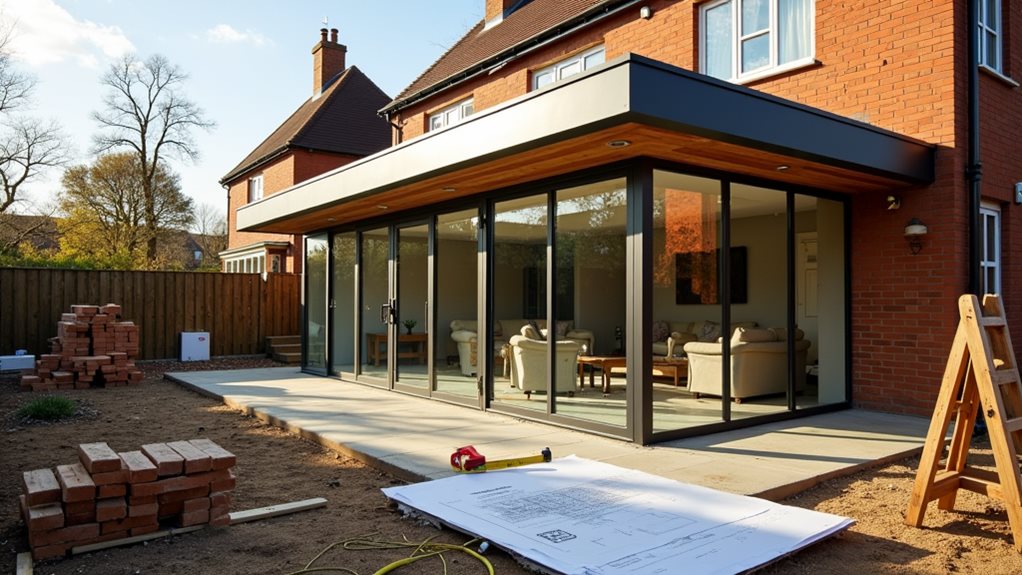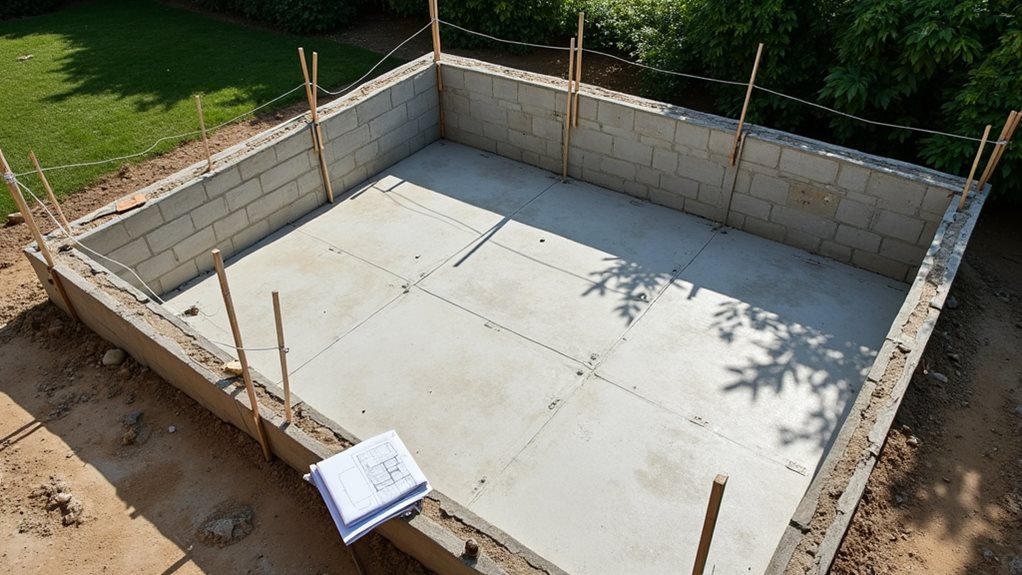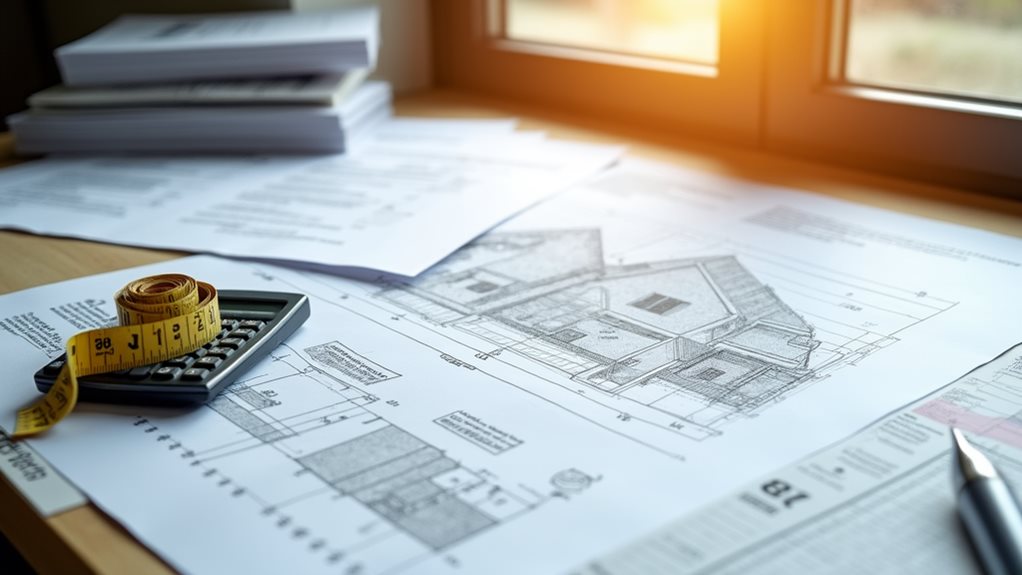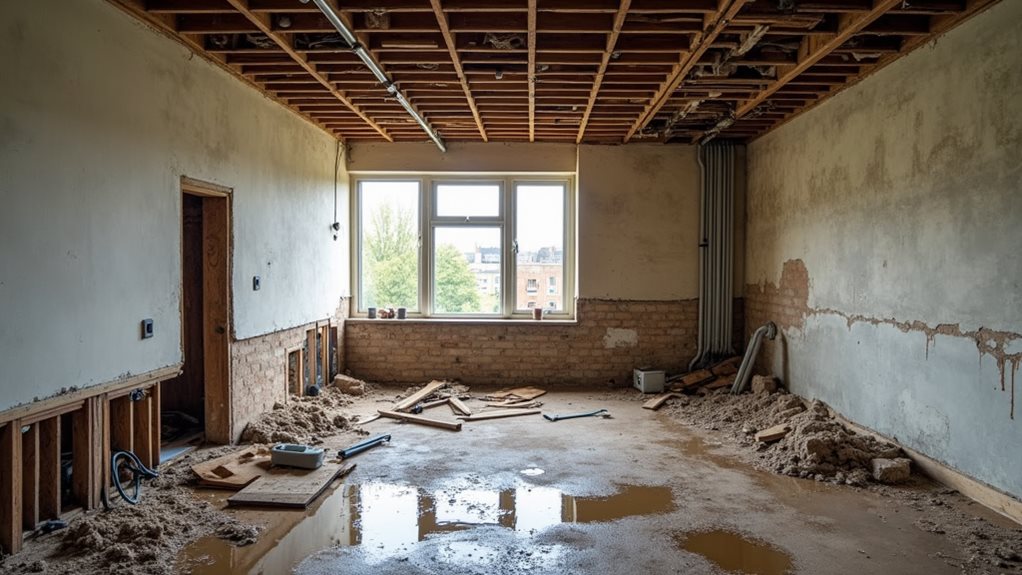Phone:
(701)814-6992
Physical address:
6296 Donnelly Plaza
Ratkeville, Bahamas.

Discover how seven surprising factors can dramatically impact your single storey extension costs before starting your home improvement project.
Your single storey rear extension's total cost depends on seven key factors: size, design complexity, location, material quality, building permissions, labor costs, and unexpected expenses. Costs typically range from £1,000 to £4,000 per square meter, with size and location having the most significant impact. Design features, such as roof type and architectural elements, can substantially affect your budget, while material choices influence both immediate costs and long-term value. Understanding these factors will help you plan your extension project more effectively.

When planning a single-storey rear extension, understanding the relationship between size and cost becomes essential for managing your budget effectively.
You'll find that size implications directly affect your overall expenses, with costs typically ranging from £1,000 to £4,000 per square meter depending on your choices and location. Increasing the size of your extension may also necessitate professional assistance to ensure that all aspects of the project meet local regulations.
The cost breakdown reveals that budget-friendly extensions start at £1,250 per square meter, while premium options can reach £4,000 per square meter. Construction often takes several months, leading to temporary living disruptions during the project timeline.
If you're working with a modest budget, you'll want to aim for the £1,000-£1,500 per square meter range, which represents standard construction costs. Remember that as your extension's size increases, you'll need more materials and labor, which will proportionally impact your total investment.
It's a straightforward equation: larger space equals higher costs.
The architectural elements you choose for your single-storey extension, from window configurations to decorative trims, will greatly impact your overall costs and the project's complexity.
Your roof design selection, whether you're opting for a flat roof, pitched roof, or incorporating skylights, can drastically affect both the structural requirements and final price tag.
When planning your extension's layout, you'll need to take into account how internal modifications to your existing space will integrate with the new addition, potentially requiring structural alterations that add to the project's scope and cost. High-quality materials can enhance your extension's longevity and value, though they typically represent a larger upfront investment.
Architectural elements and design features greatly influence your extension's final cost, making it essential to balance aesthetic desires with budget constraints.
When you're exploring current design trends and architectural styles, remember that custom features like specialty ceilings or unique structural details will increase your budget considerably.
You'll find that incorporating premium materials and complex design elements, while visually striking, can profoundly impact labor costs.
If you're working with a tighter budget, you might want to contemplate simplifying some architectural details without compromising your extension's overall appeal.
For instance, you can opt for standard window configurations instead of elaborate skylights, or choose straightforward ceiling designs rather than custom installations.
Selecting an appropriate roof design stands as one of the most essential decisions you'll make for your single-storey extension, impacting both aesthetics and functionality.
Today's design trends offer you multiple options to match your home's character and budget.
Flat roof advantages include cost-effectiveness and versatility, perfect if you're looking to create a modern aesthetic or install roof lanterns for extra light.
If you're seeking pitched roof benefits, you'll find gabled designs offer excellent durability and seamlessly blend with traditional architecture.
For unique situations, specialized roof types like catslide or monopitch solutions can provide distinctive appeal while solving specific architectural challenges.
Each design carries its own cost implications, with simpler structures typically being more budget-friendly than complex configurations featuring multiple angles or custom features.
When planning your single-storey extension, layout modifications will greatly influence both your project's complexity and final costs. Your layout optimization choices, such as creating an open-plan living space or converting a garage, will determine the extent of structural changes needed.
You'll need to reflect on how you're connecting existing spaces with your new extension. For effective space utilization, you might want to incorporate sliding doors between your kitchen and dining area or add skylights for natural illumination.
If you're planning an industrial-style kitchen or orangery, you'll face additional considerations for materials and structural requirements. Remember that while features like glass roof lanterns and multiple skylights can transform your space dramatically, they'll also impact your budget considerably.
It's essential to balance your design aspirations with practical constraints and building regulations.
Your location greatly influences the cost of your single storey rear extension, with urban areas typically commanding higher prices due to increased labour costs and property values compared to rural regions.
You'll find that local building regulations, which vary by region and municipality, can add substantial costs through permits, inspections, and specific material requirements.
Your property's market value and local economic conditions will also shape the overall expense, as high-value areas often demand premium materials and finishes to maintain property aesthetics and resale potential.
The cost of building a single storey extension varies dramatically across different regions of the UK, with prices ranging from £1,800 to £3,000 per square meter in today's market.
When you're planning your extension, you'll need to take into account these regional trends, as geographical differences can greatly impact your budget.
You'll find that urban areas typically command higher prices than rural locations, while your choice of materials can help manage costs.
If you're working with a tighter budget, you can opt for basic materials at around £1,000 per square meter, while premium finishes might push your costs up to £2,200 per square meter.
It's worth noting that construction costs are rising across all regions, so you'll want to factor this into your planning and possibly think about locking in prices early.
Building a single storey extension in urban areas typically costs 30-40% more than similar projects in rural locations, largely due to the complex interplay of market forces and local constraints.
You'll find urban pricing reflects higher labor rates, stricter planning regulations, and increased material costs due to site logistics.
While rural locations offer notable benefits, including lower labor costs and more relaxed building restrictions, you'll need to factor in potentially higher transportation expenses for materials and workers.
Your rural project might benefit from easier site access and fewer neighboring property considerations, but don't overlook the impact of limited contractor availability.
Consider how your location's economic base affects costs – tourist areas often command premium rates, while agricultural regions typically offer more competitive pricing for construction projects.
Beyond geographic pricing variations, local building regulations wield substantial influence over your extension costs and project timeline.
You'll find that zoning laws and compliance requirements vary greatly between municipalities, with some areas enforcing stricter standards that can drive up your expenses.
When you're planning your extension, you'll need to navigate permitted development rights, which typically allow rear extensions up to 4m for detached houses.
If you're in a designated area, you're facing more stringent rules, particularly regarding side extensions and height limitations.
Remember that your materials must match your existing home's appearance, and you'll need to take into account boundary restrictions – especially if your extension comes within 2m of your property line.
These regulations aren't just red tape; they're essential factors in determining your project's final cost.
When planning your single-storey rear extension, material selection and quality will greatly influence both your immediate costs and long-term value.
Your material sourcing decisions and aesthetic preferences need careful consideration, as high-quality materials typically command premium prices and may require specialized installation.
You'll find that choosing between traditional materials like brick and wood versus modern options such as glass and metal can profoundly impact your budget.
While premium materials might initially stretch your finances, they often prove cost-effective in the long run through improved durability and energy efficiency.
You can manage costs by exploring local suppliers, considering reclaimed materials, or timing your purchases during off-peak seasons.

Understanding the legal framework for your single-storey rear extension stands as a crucial first step before any construction begins.
You'll need to navigate both building codes and zoning laws while making certain your project adheres to Permitted Development Rights or obtaining prior approval when necessary.
For standard extensions, you're limited to 4m for detached houses and 3m for other properties, though you can extend further through the prior approval process.
You'll want to pay special attention if you're on designated land, where stricter rules apply.
Remember, even if you're within size limits, you'll need to match materials to your existing house and consider height restrictions.
It's wise to secure a lawful development certificate to protect your investment and make sure you're fully compliant with local regulations.
The labor costs associated with your single-storey rear extension will typically consume 40-50% of your total budget, making it vital to understand the pricing structure and contractor selection process.
When selecting your builder, you'll find that labor skill levels directly impact costs, with specialized tasks like plumbing and electrical work commanding higher rates.
Your contractor's reputation is significant, and while premium builders might charge up to £4,000 per square meter, they often deliver superior results.
You'll want to get multiple quotes and look for detailed cost breakdowns.
If you're considering DIY to reduce expenses, carefully evaluate your skills and available time.
Remember that professional contractors include project management services that you'd need to handle yourself, potentially affecting both timeline and quality.

Despite careful planning, you'll need to factor in several unexpected and additional expenses that can greatly impact your single-storey rear extension budget. Hidden costs often emerge during construction, from discovering asbestos to relocating unexpected utility lines beneath your property.
You're not alone in facing these challenges – they're common hurdles for many homeowners.
Smart contingency planning is essential to protect your investment. Consider setting aside 10-15% of your total budget for unforeseen issues, such as structural alterations or foundation problems that might surface during the build.
You'll also want to account for potential permit-related delays, surveyor costs, and changes to your original specifications.
Like pieces of a complex puzzle, these seven factors interweave to shape your extension's final cost. You'll find that by carefully considering each element, from the basic square footage to those unexpected surprises, you're better equipped to plan your budget realistically. Remember, you're not just building an addition – you're investing in your home's future value while creating that perfect living space you've always wanted.